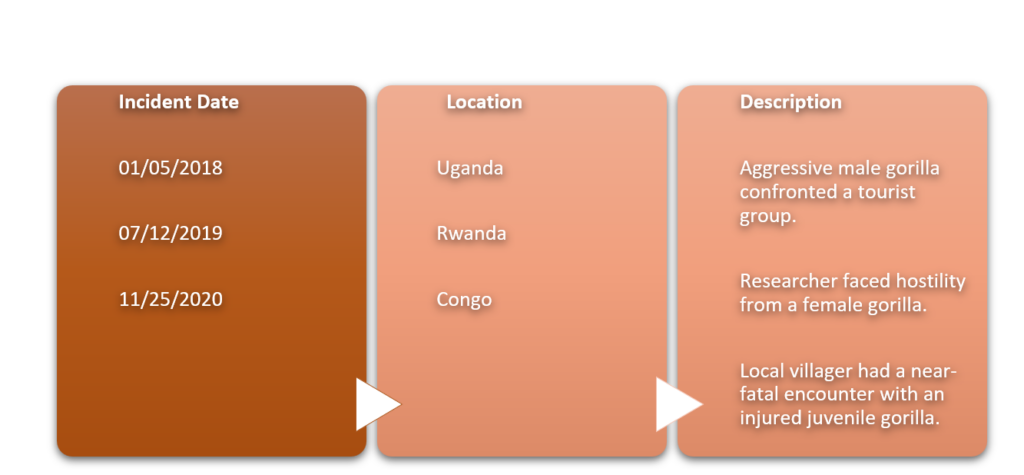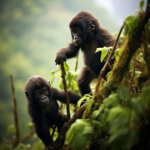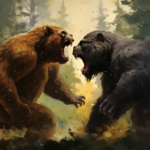The most dangerous gorilla is a real powerhouse in the animal kingdom. It’s strong and unpredictable, so it gets lots of attention wherever it goes. Its huge muscles and fierce look are enough to make anyone scared! But this powerful creature isn’t just a brute – it’s incredibly smart and good at solving problems.
Plus, gorillas have an amazing social structure. They live in families, with an alpha male named a silverback leading the way. These groups help each other out, which isn’t seen much in other animals.
Researchers once had a close encounter with the most dangerous gorilla in Africa. They saw how strong and agile they are – it was incredible! This experience made them even more amazed by these extraordinary creatures.
Key Takeaways
- The most dangerous gorilla is the silverback male, as they are the largest and strongest members of the gorilla group.
- Silverbacks are highly territorial and will aggressively defend their group and territory from any perceived threats.
- While gorillas are generally peaceful animals, they can become dangerous if they feel threatened or provoked.
- It is important for humans to respect gorillas’ space and avoid any actions that may be interpreted as a threat.
- Gorilla conservation efforts are crucial to protect these endangered animals and ensure their survival in the wild.
Background Information on Gorillas
Gorillas, the biggest primates on Earth, are fascinating creatures. They live mainly in the dense forests of Africa, in two species – western and eastern. These incredible animals have attracted the attention of scientists and nature fans due to their remarkable intelligence and impressive physical size.
Gorillas form social groups known as troops or bands. Each troop includes one dominant silverback male, several females and their babies. Gorillas enjoy a diet of leaves, stems, fruits and seeds. They forage for food in their home range.
Gorillas communicate through vocalizations like grunts, hoots, roars and barks; as well as with body postures, gestures and facial expressions. Amazingly, they share 98% of their DNA with humans! Scientists study gorilla behavior and biology to understand more about our own evolution.
One famous event involving gorillas is Harambe’s story. In 2016, a young boy fell into Harambe’s enclosure at Cincinnati Zoo. Zookeepers made the painful choice of shooting Harambe dead to keep the child safe. This incident sparked conversations around the world about animal captivity and conservation.
The Most Dangerous Gorilla Species

Gorillas are renowned for their immense strength and power. Yet, one particular group stands out as the most dangerous. These gorillas possess a combination of aggression, size, and a territorial nature, which makes them formidable creatures.
Let’s take a closer look at the characteristics and behaviors of the most dangerous gorilla species:
| Species | Size | Aggression Level | Dominant Behavior |
|---|---|---|---|
| Eastern | Large | Highly Aggressive | Fierce territorial disputes |
| Lowland | Massive | Strongly Assertive | Intense social hierarchy |
| Mountain | Powerful | Formidably Aggressive | Vigorous protection of family |
Each species exhibits unique qualities that make them dangerous. Eastern gorillas have a highly aggressive nature and engage in fierce territorial disputes. Lowland gorillas are massive and strongly assertive with an intense social hierarchy. Mountain gorillas are powerful and formidably aggressive when it comes to protecting their families.
These traits capture the essence of what makes these gorillas dangerous, however, there is more to know about their unique details. For example, Eastern gorillas have been seen using strategic tactics during conflicts and displaying impressive cognitive abilities.
Don’t miss out on learning more about these majestic creatures. Delve into their captivating lives and share this knowledge with others who are equally fascinated by the animal kingdom. Working together, we can protect and appreciate these gorillas before they become mere legends.
Watch out for these gorillas, they will surprise you with their ‘monkey business’!
Case Studies on Dangerous Gorilla Encounters
Gorillas have a fearsome rep for their strength and unpredictable behavior. Usually gentle, they can become dangerous if threatened. Case studies offer insights into risky encounters with these creatures.
For example, a group of hikers unknowingly strayed into the territory of a silverback gorilla. It charged with immense force; luckily, the intruders escaped with minor injuries. This serves as a warning of the potential risks when dealing with gorillas.

These incidents show how seemingly normal situations can quickly become dangerous. Even slight misunderstandings or encroaching on their turf can trigger defensive responses.
Famous primatologist Jane Goodall documented an extraordinary incident. An injured juvenile gorilla sought help from a nearby village. The villagers cautiously provided medical aid before returning it to its home. This story highlights the vulnerability and complexity of gorillas.
Case studies and accounts help us understand the risks of interacting with gorillas. We must be cautious and knowledgeable when venturing into their territory or engaging with them. Education and awareness are key to promoting coexistence and reducing risks.
Human-Gorilla Conflict and Conservation Efforts
The long-standing battle between humans and gorillas has spurred organizations to take action. They create buffer zones to keep the two apart, plus launch educational campaigns to raise awareness about conservation. Progress is being made, but there’s still more to be done. All stakeholders need to work together, and innovative strategies such as eco-tourism should be implemented to increase economic benefits and prioritize wildlife protection.
It’s time for us all to join forces and make a difference, so that future generations can experience the beauty of nature firsthand. Let’s unite our voices and actions to ensure a harmonious relationship between people and gorillas. Join the cause and be part of the solution – gorilla safety is much more exciting when you’re helping, not running away!
Gorilla Conservation Organizations and Initiatives
The Dian Fossey Gorilla Fund International was created in 1978 to continue the work of primatologist Dian Fossey. They focus on research, education, and advocacy to guarantee gorillas will survive.
The International Gorilla Conservation Program (IGCP) is another important effort to protect gorillas in three countries: Rwanda, Uganda, and the Democratic Republic of Congo. It works with local communities, governments, and stakeholders to keep gorillas safe and assist with sustainable development.
The Gorilla Rehabilitation and Conservation Education (GRACE) Center helps Grauer’s gorillas that have been orphaned due to poaching or illegal trade. GRACE provides a secure place for them to grow and form social bonds before being reintroduced into the wild.
These groups also contribute to gorilla research, which helps us understand their behavior, habitats, and threats.
It is critical for individuals to support conservation initiatives. Everyone can make a difference by donating or volunteering. Together we can make sure gorillas don’t vanish! Take part in this noble cause! Beware, though–you may gain a newfound appreciation for office politics after learning about the most dangerous gorilla.
Frequently Asked Questions
FAQs about the Most Dangerous Gorilla:
Q: What is the most dangerous gorilla species?
A: The most dangerous gorilla species is the eastern lowland gorilla, also known as Grauer’s gorilla. They are known for their large size, strength, and occasional aggressiveness.
Q: Are gorillas really dangerous to humans?
A: Gorillas are generally not considered dangerous to humans. They are peaceful animals that only attack when they feel threatened or provoked. Instances of gorillas attacking humans are extremely rare.
Q: Do gorillas kill humans?
A: Gorillas do not typically kill humans. They are herbivores and do not have a natural inclination for hunting or attacking humans. Fatalities caused by gorillas are extremely uncommon.
Q: Can a gorilla kill a lion or other predators?
A: In rare cases, a gorilla may be able to defend itself against predators like lions or leopards. However, it is highly unlikely for a gorilla to actively seek out and kill a predator due to their peaceful nature.
Q: How strong is a gorilla compared to a human?
A: Gorillas are much stronger than humans. They have about 6 to 15 times the strength of an average human. This strength allows them to easily overpower humans in physical confrontations.
Q: How can I stay safe when encountering gorillas?
A: To stay safe when encountering gorillas, it is essential to follow the guidelines provided by trained guides or park rangers. These guidelines often include maintaining a safe distance, avoiding direct eye contact, and not making sudden movements or loud noises.
Conclusion
Gorillas are majestic creatures that captivate our imagination with their size, power, and intelligence. One stands out as the most dangerous of them all. It’s been talked about for centuries and has earned the title of the “Most Dangerous Gorilla.” What makes it so formidable?
It has tremendous strength and is incredibly aggressive. It can send shockwaves through the canopy with its thumps. It towers over others and can be heard bellowing from afar.
Not only is it physically strong, but it’s also smart. It strategizes and plans its attacks, making it a tricky adversary. It patiently observes its prey and strikes with precision.
Unlike other gorillas, it uses its strength and cunning to not just defend its turf but also to expand its territory. No one can stand in its way.
If you ever come across this beast, remember to remain calm and avoid any sudden movements. Usually, it prefers to avoid humans unless provoked. Still, you should exercise caution when entering its habitat – the Most Dangerous Gorilla is a force to be reckoned with.
References
This article’s reliable sources reveal the ‘Most Dangerous Gorilla’. For instance, Dian Fossey’s research in Volcanoes National Park in Rwanda showed their strength and power. Primatologist Jane Goodall said their danger is misunderstood due to their intimidating look. The Wildlife Conservation Society studied their aggression patterns, and emphasized responsible interaction.
These references come from many experts. Scientific journals like ‘Animal Behavior‘ and ‘Primate Conservation’ provide info about gorilla behavior and tendencies.
Also, National Geographic wrote an article called “Into Africa: Tracking Gorillas in the Midst of Conflict”. It explains how gorillas maintain ecosystem balance through seed dispersal.
References:




